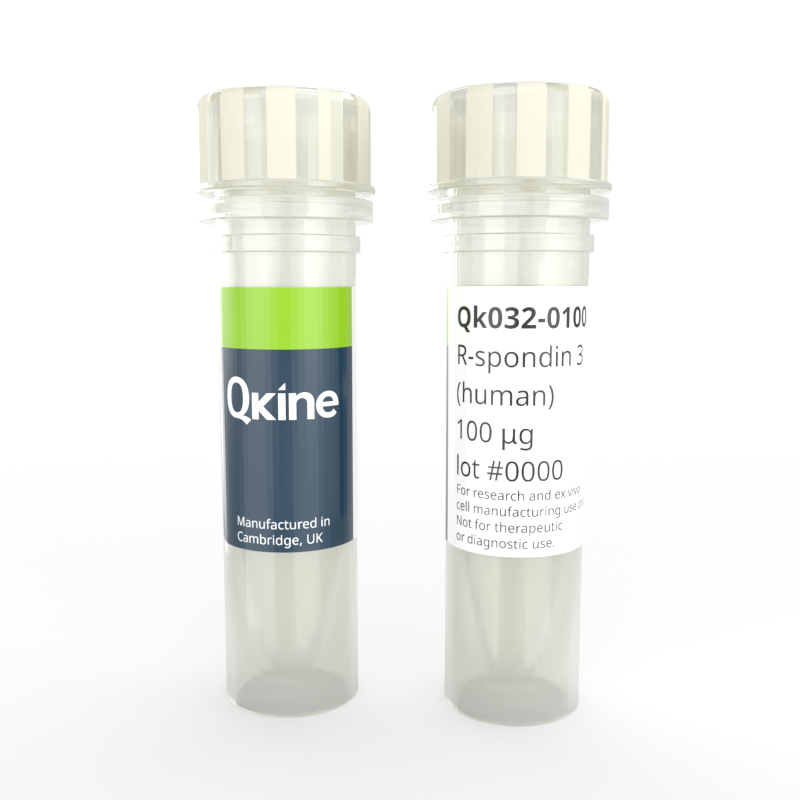Recombinant human R-spondin 3 protein
QK032
Brand: Qkine
Human R-spondin 3 protein potentiates Wnt signalling in and has been shown to function in crypt regeneration in the intestine and control stem cell and progenitor cell behaviour during kidney development. R-spondin 3 is used alongside R-spondin 1 in intestinal organoid culture systems.
Qk032 is a 17 kDa highly pure, bioactive domain of human R-spondin 3 comprising the two cysteine-rich furin-like domains, which are necessary and sufficient for Wnt signalling potentiation and are the essential domains for activity in stem cell and organoid culture. Animal origin-free and carrier-protein free.

Currency:
| Product name | Catalog number | Pack size | Price | Price (USD) | Price (GBP) | Price (EUR) |
|---|---|---|---|---|---|---|
| Recombinant human R-spondin 3 protein, 25 µg | QK032-0025 | 25 µg | (select above) | $ 260.00 | £ 190.00 | € 222.00 |
| Recombinant human R-spondin 3 protein, 50 µg | QK032-0050 | 50 µg | (select above) | $ 355.00 | £ 260.00 | € 304.00 |
| Recombinant human R-spondin 3 protein, 100 µg | QK032-0100 | 100 µg | (select above) | $ 515.00 | £ 375.00 | € 438.00 |
| Recombinant human R-spondin 3 protein, 500 µg | QK032-0500 | 500 µg | (select above) | $ 1810.00 | £ 1320.00 | € 1542.00 |
| Recombinant human R-spondin 3 protein, 1000 µg | QK032-1000 | 1000 µg | (select above) | $ 2865.00 | £ 2090.00 | € 2442.00 |
Note: prices shown do not include shipping and handling charges.
Qkine company name and logo are the property of Qkine Ltd. UK.
Alternative protein names
Species reactivity
human
Species similarity:
bovine – 98%
porcine – 98%
mouse – 97%
rat – 97%
Summary
- High purity bioactive domain of human R-spondin 3 protein (Uniprot: Q9BXY4)
- 17 kDa
- >98%, by SDS-PAGE quantitative densitometry
- Expressed in E. coli
- Animal origin-free (AOF) and carrier protein-free
- Manufactured in our Cambridge, UK laboratories
- Lyophilized from acetonitrile, TFA
- Resuspend in 10 mM HCl (Reconstitution solution A) at >50 µg/ml, add carrier protein if desired, prepare single-use aliquots and store frozen at -20 °C (short-term) or -80 °C (long-term)
Featured applications
- Chemically defined media for organoid culture
- Intestinal organoid culture
- Tumor organoid culture
Bioactivity
R-spondin 3 activity is determined using the Wnt-responsive firefly luciferase reporter assay. HEK293T cells transfected with reporter TOP-FLASH are treated in triplicate with increasing concentration of R-spondin 3 in the presence of Wnt-conditioned media (1:8 dilution). RSP1 enhances Wnt-ß catenin signaling in HEK239T cells. Cells are grown overnight, and luciferase activity is measured and normalized. EC50 = 0.3 nM (5 ng/ml). Data from Qk032 #010.

Purity
R-spondin 3 bioactive domain migrates at 17 kDa in non-reducing (-βME) conditions and upon reduction (+βME). Purified recombinant protein (7 µg) was resolved using 15% w/v SDS-PAGE in reduced (+β-mercaptothanol, R) and non-reduced conditions (NR) and stained with Coomassie Brilliant Blue R250. Data from Qk032 lot #010

Further quality assays
- Mass spectrometry: single species with expected mass
- Analytical reversed-phase: single sharp peak
- Endotoxin: <0.005 EU/μg protein (below level of detection)
- Recovery from stock vial: >95%
Protein background
R-Spondin 3 (RSPO3) protein belongs to the R-spondin family comprizing four structurally-related, secreted ligands (RSPO 1-4) [1]. All contain furin-like and thrombospondin structural domains. R-spondins are activators of the canonical Wnt signaling pathway. Receptors include the leucine-rich repeat-containing G-protein coupled receptors (LGR) 4-6 [2]. In the colon, R-spondin 3 promotes stem cell recovery and epithelial repair via induction of Wnt.
An R-spondin, such as R-spondin 3, is an essential component of Wnt 3a, R-spondin 3 (or 1,2), noggin (WRN) media used widely in propagation of intestinal organoids [2]. There is a drive towards improved reproducibility in stem cell and organoid culture. Conditioned media (spent media from cells that secrete growth factors such as Wnt and R-spondin, along with several other factors and waste products) is both challenging to manufacture consistently and conveniently, and a source of variability between labs [3].
Background references
- de Lau, W. B. M., Snel, B. & Clevers, H. C. The R-spondin protein family. Genome biology 13, 242 (2012). doi.org/10.1186/gb-2012-13-3-242
- Sato, T. et al. Single Lgr5 stem cells build crypt-villus structures in vitro without a mesenchymal niche. Nature 459, 262–265 (2009). doi.org/10.1038/nature07935
- VanDussen, K. L., Sonnek, N. M. & Stappenbeck, T. S. L-WRN conditioned medium for gastrointestinal epithelial stem cell culture shows replicable batch-to-batch activity levels across multiple research teams. Stem cell research 37, 101430 (2019). doi.org/10.1016/j.scr.2019.101430
Publications using recombinant human R-spondin 3 protein (Qk032)
Mass Generation and Long-term Expansion of Hepatobiliary Organoids from Adult Primary Human Hepatocytes
Marsee A, Ritchie A, Myszczyszyn A et al.
DOI: https://doi.org/10.1101/2024.06.10.598262